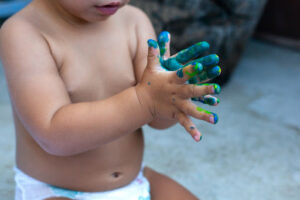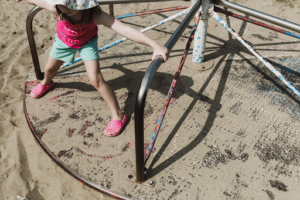
Therapeutic brushing may be recommended for your child due to tactile defensiveness, or difficulty tolerating a variety of textures. However, engaging in a therapeutic brushing protocol may also help to ease sensory-based anxiety, promote falling asleep, increase attention to task, increase coordination, and overall self-regulation.
What is Therapeutic Brushing?
The Wilbarger Deep Pressure and Proprioceptive Technique (DPPT), also known as the Wilbarger Brushing Protocol, is often used by occupational therapists to promote sensory integration. It is typically used with children demonstrating sensory defensiveness, or children who exhibit signs of over-responsiveness in the protective responses of the nervous system. Oftentimes, it is used with children who exhibit tactile defensiveness, or difficulty being touched by people or a variety of textures.
What Does the Protocol Look Like?
DPPT begins with systematic brushing of the body, followed by joint compressions to a child’s arms, legs, hands, feet, and head. Brushing is completed using a soft surgical scrub brush, often called a Therapressure brush. The correct brush is required in this protocol, as it provides a specific type of sensation to the nerve endings in the skin. Firm, even pressure is used to sequentially brush the arms, back, legs, and feet. Areas such as the stomach and chest are always avoided, as they are particularly sensitive. Following brushing, 10 joint compressions are provided to the child’s hands, wrists, elbows, shoulders, hips, knees, ankles, and feet using gentle pressure. This provides the child with deep pressure proprioceptive input which is calming to the nervous system. The protocol is repeated approximately every two hours while the child is awake. DPPT must always be taught by a trained therapist to ensure that it is safe, effective, and beneficial for the child.
What Does Brushing Do for Sensory Integration?
The brushing portion of DPPT stimulates the nerve endings of the skin, generally serving to “wake up” the nervous system. The joint compressions provide the body with deep pressure proprioceptive input, which typically calms nervous system. Performing the two elements of the protocol helps the central nervous system to better utilize information from the nerve endings of the peripheral nervous system more effectively. This can result in increased overall regulation, decreased anxiety to sensory triggers, and improved ability to transition between challenging tasks.
Who Would Benefit from Therapeutic Brushing?
Your child may benefit from DPPT if he or she:
- Demonstrates difficulty being touched, wearing a variety of clothing, or tolerating a messy play.
- Becomes reactive with grooming activities, including having his or her hair washed, or fingernails clipped.
- Demonstrates difficulty maintaining a calm, alert, and organized state.
- Experiences difficulty calming down and falling asleep at night.
- Demonstrates difficulty transitioning between activities
- Appears to have trouble noticing when he or she is hungry or needs to go to the bathroom.
Questions or concerns?
If you think your child could benefit from DPPT, please reach out to your occupational therapist or us at info@playworkschicago.com or 773-332-9439.
Natalie Machado, MS, OTR/L
Occupational Therapist
References:
OT-Innovations.com. (2018). Therapeutic brushing techniques. Retrieved from https://www.ot-innovations.com/clinical-practice/sensory-modulation/therapeutic-brushing-techniques/.













